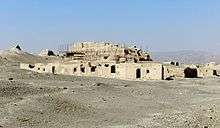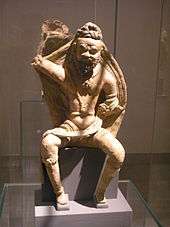Shikshin Temple
The Qigexing Temple (Uyghur: Хорчу, ULY: Xorqu ; simplified Chinese: 七个星佛寺; traditional Chinese: 七個星佛寺; pinyin: Qīgèxīng Fósì; lit.: 'Seven-Stars Buddhist Temple') is a ruined compound of Buddhist sites located about 25–30 km southwest of the town of Karasahr, Yanqi Hui Autonomous County, Xinjiang, China. The site was a major religious center along the northern route of the Silk Road in the second half of the first millennium CE.
 View of the ruins | |
 Location of the site in Xinjiang, China | |
| Location | Xinjiang, China |
|---|---|
| Coordinates | 41.936°N 86.341°E |
| Site notes | |
| Condition | In ruins |
Names


The site's Chinese name "Qigexing" has also been spelled as "Shikchin", "Shikshin", "Šikšin", "Xikeqin", or "Xigexing". The archaeologist Albert Grünwedel who worked at the site during the third German Turfan expedition (1905-1907) referred to the site as "Šorčuq"[1](derived from the Uyghur name Xorqu), this name is also sometimes spelled as Shorchuk,[2][3] "Chorchuk",[4] or "Shorchuq"[5] and may refer to salt deposits in the surrounding steppes.[1][2] The site is also referred to as "Ming oi" or "Mingoi", a term that literally means "Thousand Dwellings" in the Uyghur language[2] and is also used for other temple sites in the region such as the Kizil Caves.
History

In prehistory Qigexing was part of the city state of Ārśi or Agni (now known as Karasahr/Qarasheher). Ārśi is believed to have been the homeland of an extinct Indo-European language known as "Tocharian A", or Agnean, and was significant in the introduction of Buddhism to China. As late as the 6th century CE, Buddhist works and official documents were being written in Tocharian A. Ārśi was mentioned in Chinese sources, as early as the Han Dynasty, as the Kingdom of Yanqi (Chinese: 焉耆; pinyin: Yanqi or Yen-ch'i – a derivative of Ārśi/Agni).
Qigexing was conquered by the Han Dynasty in 94 CE, during its reconquest of the Tarim Basin. The Buddhist monk Faxian visited the area of Yanqi around 400 CE and mentions the presence of about 4,000 monks who were practicing Hinayana Buddhism.[6]
The monk Xuanzang, who lived in the 7th century CE, reports the existence of 10 Buddhist monasteries with 2,000 monks who belonged to the Sarvastivada school of Buddhism in the area around Yanqi.[6] In 644 CE, the Tang Dynasty invaded and annexed Yanqi during their wars against the Western Turks, a conflict that would last until the Turks were defeated in 657 CE. Tang control of the kingdom was re-established in 648 CE when a Tang general defeated a usurper who had deposed the puppet ruler that the Tang installed four years before.[7] In 719 CE, the Tang established one of the Four Garrisons of Anxi in Yanqi, the other garrisons were in Kucha, Kashgar, and Hotan. Aurel Stein hypothesized that the Buddhist temples of Qigexing were burned during an iconoclasm after Islam became the state religion of the Kara-Khanid Khanate.[2]
Archeological finds in Qigexing include the ruins of larger temple compounds (with more than 100 buildings in total[6]) as well as twelve cave temples.[1][6] The remains of some wall paintings and in particular sculptures have been discovered at the site. Sculptures have been found as individual figures as well as in friezes. The style of the artworks mixes indo-Iranian elements with Chinese styles.[6] The depiction of human heads at the site has a characteristic style with faces that are bulged out like balloons.[6] The Qigexing site is also an important source for manuscripts written in the East Tocharian language, also known as Tocharian A or Agnean after Agni an ancient name for Yanqi. Of the 1150 leaves and fragments in East Tocharian that were included in a 2007 survey, 383 came from a single scriptorum in Qigexing.[3]
The site was investigated by Albert Grünwedel during third German Turfan expedition (1905-1907),[1][8] by Aurel Stein in December 1907,[2] as well as by Sergey Oldenburg during the Russian Turkistan Expedition (1909-1910).[9]
References
- Albert Grünwedel: Altbuddhistische Kultstätten in Chinesisch-Turkistan, Bericht über archäologische Arbeiten von 1906 bis 1907 bei Kucha, Qarašahr und in der Oase Turfan, Berlin, 1912
- Aurel Stein: Serindia - Detailed Report of Explorations in Central Asia and Westernmost China, Oxford at the Clarendon Press, 1921
- Valerie Hansen, The Silk Road: A New History, Oxford University Press, Jul 17, 2012
- Aurel Stein: Ruins of Desert Cathay: personal narrative of explorations in Central Asia and westernmost China, Volume 2, Macmillan and co., 1912
- Baij Nath Puri: Buddhism In Central Asia, Motilal Banarsidass Publ., 1987
- Marianne Yaldız: Archäologie und Kunstgeschichte Chinesisch-Zentralasiens (Xinjiang), Leiden, 1987
- Wechsler, Howard J.; Twitchett, Dennis C. (1979). Denis C. Twitchett; John K. Fairbank (eds.). The Cambridge History of China, Volume 3: Sui and T'ang China, 589–906, Part I. Cambridge University Press. pp. 225–227. ISBN 978-0-521-21446-9.
- Zaturpanskij, Choros (i.e. A. v. Le Coq): Reisewege und Ergebnisse der deutschen Turfanexpeditionen, Orientalisches Archiv 3, 1912, pp. 116–127
- S. F. Oldenburg: Russian Turkistan Expedition, 1909-1910, vol. 1, 1914
External links
- Along the ancient silk routes: Central Asian art from the West Berlin State Museums, an exhibition catalog from The Metropolitan Museum of Art (fully available online as PDF), which contains material from Qigexing Buddhist Temple Ruins